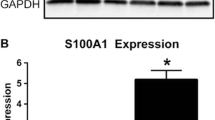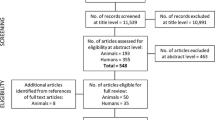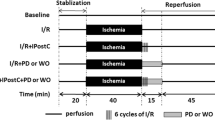Abstract
Nitric oxide modulates the severity of myocardial ischemia–reperfusion (I/R) injury. We investigated whether cardioselective nitric oxide synthase 3 (NOS3) gene transfer could confer myocardial protection against I/R injury in pigs and examined potential molecular mechanisms. I/R injury was induced by balloon occlusion of the left anterior descending artery for 45 min followed by 4 or 72 h reperfusion. Hemodynamic and pathological changes were measured in pigs in the absence (n = 11) or presence of prior intracoronary retroinfusion of human NOS3 (AdNOS3, 5 × 1010 PFU, n = 13) or control vector (AdRR5, 5 × 1010 PFU, n = 11). Retrograde NOS3 gene transfer selectively increased NOS3 expression and NO bioavailability in the area at risk (AAR) without changing endogenous NOS isoform expression. At 4 h R, LV systolic (dP/dt max) and diastolic (dP/dt min) function was better preserved in AdNOS3- than in AdRR5-injected pigs (2,539 ± 165 vs. 1,829 ± 156 mmHg/s, and −2,781 ± 340 vs. −2,062 ± 292 mmHg/s, respectively, P < 0.05 for both). Myocardial infarct size (% AAR) was significantly smaller in AdNOS3 than in control and AdRR5 and associated with a significantly greater reduction in cardiac myeloperoxidase activity, a marker of neutrophil infiltration. The latter effects were sustained at 72 h R in a subset of pigs (n = 7). In the AAR, intercellular endothelial adhesion molecule-1 expression and cardiomyocyte apoptosis were significantly lower in AdNOS3. In conclusion, single myocardial NOS3 retroinfusion attenuates I/R injury, and causes a sustained reduction in myocardial infarct size and inflammatory cell infiltration. Gene-based strategies to increase NO bioavailability may have therapeutic potential in myocardial I/R.





Similar content being viewed by others
References
Boekstegers P, von Degenfeld G, Giehrl W, Heinrich D, Hullin R, Kupatt C, Steinbeck G, Baretton G, Middeler G, Katus H, Franz WM (2000) Myocardial gene transfer by selective pressure-regulated retroinfusion of coronary veins. Gene Ther 7:232–240
Bott-Flugel L, Weig HJ, Knodler M, Stadele C, Moretti A, Laugwitz KL, Seyfarth M (2005) Gene transfer of the pancaspase inhibitor P35 reduces myocardial infarct size and improves cardiac function. J Mol Med 83:526–534
Brunner F, Maier R, Andrew P, Wolkart G, Zechner R, Mayer B (2003) Attenuation of myocardial ischemia/reperfusion injury in mice with myocyte-specific overexpression of endothelial nitric oxide synthase. Cardiovasc Res 57:55–62
Chao J, Yin H, Yao YY, Shen B, Smith RS Jr, Chao L (2006) Novel role of kallistatin in protection against myocardial ischemia-reperfusion injury by preventing apoptosis and inflammation. Hum Gene Ther 17:1201–1213
De Frutos T, Sanchez de Miguel L, Farre J, Gomez J, Romero J, Marcos-Alberca P, Nunez A, Rico L, Lopez-Farre A (2001) Expression of an endothelial-type nitric oxide synthase isoform in human neutrophils: modification by tumor necrosis factor-alpha and during acute myocardial infarction. J Am Coll Cardiol 37:800–807
Elrod JW, Calvert JW, Gundewar S, Bryan NS, Lefer DJ (2008) Nitric oxide promotes distant organ protection: evidence for an endocrine role of nitric oxide. Proc Natl Acad Sci USA 105:11430–11435
Elrod JW, Greer JJ, Bryan NS, Langston W, Szot JF, Gebregzlabher H, Janssens S, Feelisch M, Lefer DJ (2006) Cardiomyocyte-specific overexpression of NO synthase-3 protects against myocardial ischemia-reperfusion injury. Arterioscler Thromb Vasc Biol 26:1517–1523
Fraccarollo D, Widder JD, Galuppo P, Thum T, Tsikas D, Hoffmann M, Ruetten H, Ertl G, Bauersachs J (2008) Improvement in left ventricular remodeling by the endothelial nitric oxide synthase enhancer AVE9488 after experimental myocardial infarction. Circulation 118:818–827
Frantz S, Adamek A, Fraccarollo D, Tillmanns J, Widder JD, Dienesch C, Schafer A, Podolskaya A, Held M, Ruetten H, Ertl G, Bauersachs J (2009) The eNOS enhancer AVE 9488: a novel cardioprotectant against ischemia reperfusion injury. Basic Res Cardiol 104:773–779
Garcia-Dorado D, Agullo L, Sartorio CL, Ruiz-Meana M (2009) Myocardial protection against reperfusion injury: the cGMP pathway. Thromb Haemost 101:635–642
Hall G, Hasday JD, Rogers TB (2006) Regulating the regulator: NF-kappaB signaling in heart. J Mol Cell Cardiol 41:580–591
Hamid SA, Totzeck M, Drexhage C, Thompson I, Fowkes RC, Rassaf T, Baxter GF (2009) Nitric oxide/cGMP signalling mediates the cardioprotective action of adrenomedullin in reperfused myocardium. Basic Res Cardiol. doi:10.1007/s00395-009-0058-7
Heinzel FR, Gres P, Boengler K, Duschin A, Konietzka I, Rassaf T, Snedovskaya J, Meyer S, Skyschally A, Kelm M, Heusch G, Schulz R (2008) Inducible nitric oxide synthase expression and cardiomyocyte dysfunction during sustained moderate ischemia in pigs. Circ Res 103:1120–1127
Heusch G, Boengler K, Schulz R (2008) Cardioprotection: nitric oxide, protein kinases, and mitochondria. Circulation 118:1915–1919
Heusch G, Post H, Michel MC, Kelm M, Schulz R (2000) Endogenous nitric oxide and myocardial adaptation to ischemia. Circ Res 87:146–152
Janssens S, Pokreisz P, Schoonjans L, Pellens M, Vermeersch P, Tjwa M, Jans P, Scherrer-Crosbie M, Picard MH, Szelid Z, Gillijns H, Van de Werf F, Collen D, Bloch KD (2004) Cardiomyocyte-specific overexpression of nitric oxide synthase 3 improves left ventricular performance and reduces compensatory hypertrophy after myocardial infarction. Circ Res 94:1256–1262
Janssens SP, Bloch KD, Nong Z, Gerard RD, Zoldhelyi P, Collen D (1996) Adenoviral-mediated transfer of the human endothelial nitric oxide synthase gene reduces acute hypoxic pulmonary vasoconstriction in rats. J Clin Invest 98:317–324
Jaski BE, Jessup ML, Mancini DM, Cappola TP, Pauly DF, Greenberg B, Borow K, Dittrich H, Zsebo KM, Hajjar RJ (2009) Calcium upregulation by percutaneous administration of gene therapy in cardiac disease (CUPID Trial), a first-in-human phase 1/2 clinical trial. J Card Fail 15:171–181
Jones SP, Girod WG, Palazzo AJ, Granger DN, Grisham MB, Jourd’Heuil D, Huang PL, Lefer DJ (1999) Myocardial ischemia-reperfusion injury is exacerbated in absence of endothelial cell nitric oxide synthase. Am J Physiol 276:H1567–H1573
Jones SP, Greer JJ, Kakkar AK, Ware PD, Turnage RH, Hicks M, van Haperen R, de Crom R, Kawashima S, Yokoyama M, Lefer DJ (2004) Endothelial nitric oxide synthase overexpression attenuates myocardial reperfusion injury. Am J Physiol Heart Circ Physiol 286:H276–H282
Kupatt C, Dessy C, Hinkel R, Raake P, Daneau G, Bouzin C, Boekstegers P, Feron O (2004) Heat shock protein 90 transfection reduces ischemia-reperfusion-induced myocardial dysfunction via reciprocal endothelial NO synthase serine 1177 phosphorylation and threonine 495 dephosphorylation. Arterioscler Thromb Vasc Biol 24:1435–1441
Kupatt C, Hinkel R, Vachenauer R, Horstkotte J, Raake P, Sandner T, Kreuzpointner R, Muller F, Dimmeler S, Feron O, Boekstegers P (2003) VEGF165 transfection decreases postischemic NF-kappa B-dependent myocardial reperfusion injury in vivo: role of eNOS phosphorylation. FASEB J 17:705–707
Kupatt C, Hinkel R, von Bruhl ML, Pohl T, Horstkotte J, Raake P, El Aouni C, Thein E, Dimmeler S, Feron O, Boekstegers P (2007) Endothelial nitric oxide synthase overexpression provides a functionally relevant angiogenic switch in hibernating pig myocardium. J Am Coll Cardiol 49:1575–1584
Lefer AM, Campbell B, Scalia R, Lefer DJ (1998) Synergism between platelets and neutrophils in provoking cardiac dysfunction after ischemia and reperfusion: role of selectins. Circulation 98:1322–1328
Liu X, Huang Y, Pokreisz P, Vermeersch P, Marsboom G, Swinnen M, Verbeken E, Santos J, Pellens M, Gillijns H, Van de Werf F, Bloch KD, Janssens S (2007) Nitric oxide inhalation improves microvascular flow and decreases infarction size after myocardial ischemia and reperfusion. J Am Coll Cardiol 50:808–817
MacArthur PH, Shiva S, Gladwin MT (2007) Measurement of circulating nitrite and S-nitrosothiols by reductive chemiluminescence. J Chromatogr B Analyt Technol Biomed Life Sci 851:93–105
Maejima Y, Adachi S, Morikawa K, Ito H, Isobe M (2005) Nitric oxide inhibits myocardial apoptosis by preventing caspase-3 activity via S-nitrosylation. J Mol Cell Cardiol 38:163–174
Mahon NG, Madden BP, Caforio AL, Elliott PM, Haven AJ, Keogh BE, Davies MJ, McKenna WJ (2002) Immunohistologic evidence of myocardial disease in apparently healthy relatives of patients with dilated cardiomyopathy. J Am Coll Cardiol 39:455–462
Matsubara H, Takaki M, Yasuhara S, Araki J, Suga H (1995) Logistic time constant of isovolumic relaxation pressure-time curve in the canine left ventricle. Better alternative to exponential time constant. Circulation 92:2318–2326
Matsui T, Tao J, del Monte F, Lee KH, Li L, Picard M, Force TL, Franke TF, Hajjar RJ, Rosenzweig A (2001) Akt activation preserves cardiac function and prevents injury after transient cardiac ischemia in vivo. Circulation 104:330–335
Miura T, Miki T (2008) Limitation of myocardial infarct size in the clinical setting: current status and challenges in translating animal experiments into clinical therapy. Basic Res Cardiol 103:501–513
Moens AL, Champion HC, Claeys MJ, Tavazzi B, Kaminski PM, Wolin MS, Borgonjon DJ, Van Nassauw L, Haile A, Zviman M, Bedja D, Wuyts FL, Elsaesser RS, Cos P, Gabrielson KL, Lazzarino G, Paolocci N, Timmermans JP, Vrints CJ, Kass DA (2008) High-dose folic acid pretreatment blunts cardiac dysfunction during ischemia coupled to maintenance of high-energy phosphates and reduces postreperfusion injury. Circulation 117:1810–1819
Mullane KM, Kraemer R, Smith B (1985) Myeloperoxidase activity as a quantitative assessment of neutrophil infiltration into ischemic myocardium. J Pharmacol Methods 14:157–167
Padilla F, Garcia-Dorado D, Agullo L, Inserte J, Paniagua A, Mirabet S, Barrabes JA, Ruiz-Meana M, Soler-Soler J (2000) L-Arginine administration prevents reperfusion-induced cardiomyocyte hypercontracture and reduces infarct size in the pig. Cardiovasc Res 46:412–420
Palazzo AJ, Jones SP, Anderson DC, Granger DN, Lefer DJ (1998) Coronary endothelial P-selectin in pathogenesis of myocardial ischemia- reperfusion injury. Am J Physiol 275:H1865–H1872
Raake PW, Hinkel R, Muller S, Delker S, Kreuzpointner R, Kupatt C, Katus HA, Kleinschmidt JA, Boekstegers P, Muller OJ (2008) Cardio-specific long-term gene expression in a porcine model after selective pressure-regulated retroinfusion of adeno-associated viral (AAV) vectors. Gene Ther 15:12–17
Rajagopalan S, Olin J, Deitcher S, Pieczek A, Laird J, Grossman PM, Goldman CK, McEllin K, Kelly R, Chronos N (2007) Use of a constitutively active hypoxia-inducible factor-1alpha transgene as a therapeutic strategy in no-option critical limb ischemia patients: phase I dose-escalation experience. Circulation 115:1234–1243
Schulz R, Kelm M, Heusch G (2004) Nitric oxide in myocardial ischemia/reperfusion injury. Cardiovasc Res 61:402–413
Shiva S, Gladwin MT (2009) Nitrite mediates cytoprotection after ischemia/reperfusion by modulating mitochondrial function. Basic Res Cardiol 104:113–119
Stewart DJ, Hilton JD, Arnold JM, Gregoire J, Rivard A, Archer SL, Charbonneau F, Cohen E, Curtis M, Buller CE, Mendelsohn FO, Dib N, Page P, Ducas J, Plante S, Sullivan J, Macko J, Rasmussen C, Kessler PD, Rasmussen HS (2006) Angiogenic gene therapy in patients with nonrevascularizable ischemic heart disease: a phase 2 randomized, controlled trial of AdVEGF(121) (AdVEGF121) versus maximum medical treatment. Gene Ther 13:1503–1511
Szelid Z, Sinnaeve P, Vermeersch P, Gillijns H, Pellens M, Laurysens V, Van Pelt N, Flameng W, Sergeant P, Herijgers P, Pokreisz P, Van Zonneveld AJ, Verbeken E, Collen D, Janssens S (2002) Preexisting antiadenoviral immunity and regional myocardial gene transfer: modulation by nitric oxide. Hum Gene Ther 13:2185–2195
Takahashi SS, Omori Y, Miyazaki H, Yoshino F, Shoji H, Lee MC, Todoki K, Kamibayashi M, Murakami E (2003) Real-time monitoring of nitric oxide in ischemic myocardium using an NO-selective electrode calibrated by electron spin resonance. Life Sci 74:75–85
Verma S, Maitland A, Weisel RD, Fedak PW, Pomroy NC, Li SH, Mickle DA, Li RK, Rao V (2002) Novel cardioprotective effects of tetrahydrobiopterin after anoxia and reoxygenation: Identifying cellular targets for pharmacologic manipulation. J Thorac Cardiovasc Surg 123:1074–1083
Westermann D, Riad A, Richter U, Jager S, Savvatis K, Schuchardt M, Bergmann N, Tolle M, Nagorsen D, Gotthardt M, Schultheiss HP, Tschope C (2009) Enhancement of the endothelial NO synthase attenuates experimental diastolic heart failure. Basic Res Cardiol 104:499–509
Yellon DM, Hausenloy DJ (2007) Myocardial reperfusion injury. N Engl J Med 357:1121–1135
Acknowledgments
This work was supported by a scholarship from the K.U. Leuven and the Soros Foundation Hungary (Dr. Szelid) and by Research Fund of K.U. Leuven GOA/2007/13 (Dr. Janssens and Dr. Pokreisz). Dr. Stefan Janssens is a Principal Investigator of the Flanders Institute for Biotechnology (VIB) and holder of a chair in cardiology sponsored by Astra Zeneca.
Conflict of interest statement
None.
Author information
Authors and Affiliations
Corresponding author
Additional information
Z. Szelid and P. Pokreisz contributed equally to the study.
Rights and permissions
About this article
Cite this article
Szelid, Z., Pokreisz, P., Liu, X. et al. Cardioselective nitric oxide synthase 3 gene transfer protects against myocardial reperfusion injury. Basic Res Cardiol 105, 169–179 (2010). https://doi.org/10.1007/s00395-009-0077-4
Received:
Revised:
Accepted:
Published:
Issue Date:
DOI: https://doi.org/10.1007/s00395-009-0077-4




